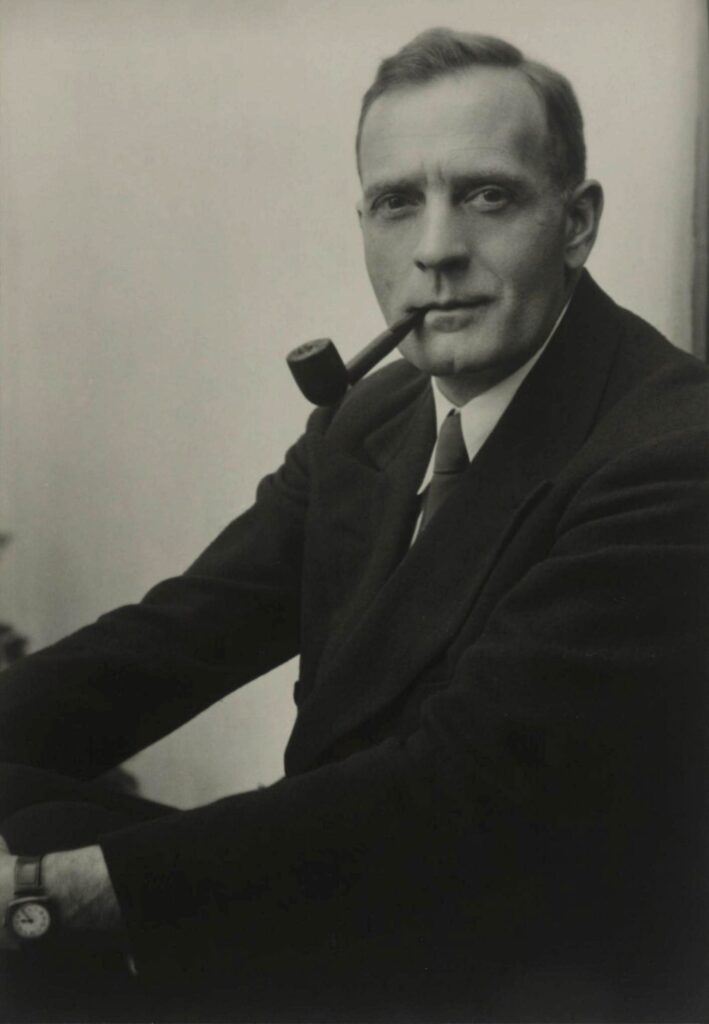Through his use of the largest telescope of his time, the 100-inch reflector at the Mount Wilson Observatory, Dr. Edwin Hubble revolutionized man’s knowledge of the size, structure, and properties of the universe. His greatest discovery was the linear relationship between a galaxy’s distance and the speed with which it is moving, now known as the Hubble Constant.
Edwin Powell Hubble was born on November 20, 1889, in Marshfield, Missouri. His father, a lawyer who was also an insurance executive, moved the family to Chicago, Illinois in 1898. Upon graduation from Wheaton High School in Wheaton, Illinois Edwin was awarded a scholarship to the University of Chicago, where he earned a Bachelor’s Degree in Physics. In 1910, he was named a Rhodes scholar at Queens College, Oxford, England, where he studied Roman and English Law.
Hubble returned to the United States in l913, and though he passed the bar examination and practiced law for a year in Louisville, Kentucky, he soon decided to pursue his dream of a career in astronomy. In l914, he returned to the University of Chicago for postgraduate work leading to a doctoral degree in astronomy.
Although Hubble was invited to join the staff of the Mount Wilson Observatory, Pasadena, California in 1917, he finished his Ph.D. instead, then volunteered for the U.S. Army. After combat service in France during World War I, Hubble was mustered out of the army as a major in l9l9 after which he accepted the offer to work at the Mount Wilson Observatory.
When Hubble began his career there, it was thought that the known universe was within the Milky Way galaxy, which was the only galaxy in existence. Then in 1923, Edwin Hubble trained the 100-inch Hooker telescope at Mount Wilson on a hazy patch of sky called the Andromeda Nebula. He found that it contained stars just like the ones in the Milky Way galaxy, only dimmer. Soon Hubble deduced that the Andromeda Nebula was not a nearby star cluster but rather an entire galaxy, which is now called the Andromeda galaxy.
Hubble continued his research and soon discovered many other galaxies that had been misidentified as nebulae, and by the end of the 1920s, it was evident that the Milky Way was but one of millions of galaxies in the universe. In scientific circles, this was a shift in thought as profound as understanding the world was round and that it revolved around the sun. By 1930, Hubble had discovered enough galaxies to compare them to each other. He created a system for classifying galaxies based on their shape that is still used today, in an evolved form.
Dr. Hubble’s other great discovery was that the farther apart galaxies are, the faster they are moving away from each other. Based on this observation, Hubble concluded that the universe is expanding uniformly. Several scientists had also posed this theory based on Einstein’s General Relativity but in 1929, Hubble and his colleague Milton Humason were able to establish the expansion rate of the universe, which is now known as the Hubble Constant. Their data showed that all galaxies, and everything else in the Universe, had originated in the “Big Bang,” billions of years in the past.
Edwin Hubble worked at the Mount Wilson Observatory until the summer of 1942, when he left to do war-related work at the Aberdeen Proving Ground, Maryland. For this valuable service to his country, he was awarded the Medal of Merit in 1946. After World War II, Dr. Hubble returned to the Mount Wilson Observatory to help design the 200-inch Hale telescope and to serve on the Mount Wilson Observatory Advisory Committee for building the Mount Palomar Observatory. Dr. Hubble continued his research at the Mount Wilson and Palomar Observatories until his death from cerebral thrombosis, in San Marino, California on September 28, 1953.
Hubble’s work forms the foundation of modern cosmology, the study of the origin of the universe. He is immortalized by many astronomical concepts: Hubble’s zone of avoidance, the Hubble galaxy type, the Hubble sequence, the Hubble luminosity law for reflection nebulae, the Hubble luminosity profile for E galaxies, the Hubble constant, the Hubble time, the Hubble diagram, the Hubble red-shift-distance relation, and the Hubble radius for the universe.
Edwin Hubble’s name is also associated with mankind’s most advanced optical telescope, the Hubble Space Telescope. Since its repair in 1993, it has produced the most remarkable images of distant galaxies mankind has ever seen. Dr. Hubble’s name has also been given to a lunar crater and asteroid 2069 Hubble.

